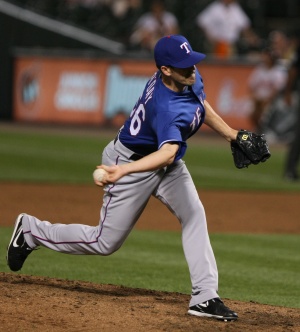Thrower's Shoulder: Difference between revisions
No edit summary |
No edit summary |
||
| Line 9: | Line 9: | ||
== Further Information == | == Further Information == | ||
Treatment of the Thrower's shoulder is exceptionally challenging. Awareness and understanding of the throwing motion and the forces the structures are subject to are essential to diagnosis and treatment. See [[Throwing Biomechanics|Throwing biomechanics]] | Treatment of the Thrower's shoulder is exceptionally challenging. Awareness and understanding of the throwing motion and the forces the structures are subject to are essential to diagnosis and treatment.<ref>Seroyer ST, Nho SJ, Bach Jr BR, Bush-Joseph CA, Nicholson GP, Romeo AA. [https://www.ncbi.nlm.nih.gov/pmc/articles/PMC3445067/ Shoulder pain in the overhead throwing athlete.] Sports health. 2009 Jan;1(2):108-20.Available:https://www.ncbi.nlm.nih.gov/pmc/articles/PMC3445067/ (accessed 12.1.2023)</ref> See [[Throwing Biomechanics|Throwing biomechanics]] | ||
Huge stresses are placed on the thrower’s shoulder during the overhead motion. Isolated injuries of the shoulder structures may occur, but more typically a cascade of pathologic changes is commonly in the overhead throwing athlete. Common injuries seen in the Thrower's shoulder include superior labral tears, partial-thickness tears of the posterior supraspinatus and anterior portion of the infraspinatus, a tight posterior capsule, and anterior instability.<ref>Musculoskeletal Key [https://musculoskeletalkey.com/the-throwers-shoulder-3/ The Thrower’s Shoulder] Available:https://musculoskeletalkey.com/the-throwers-shoulder-3/ (accessed 12.1.2023)</ref> | |||
SLAP Tears | SLAP Tears | ||
| Line 25: | Line 25: | ||
Glenohumeral Internal Rotation Deficit (GIRD) | Glenohumeral Internal Rotation Deficit (GIRD) | ||
Scapular rotation dysfunction | Scapular rotation dysfunction<ref>Orthobullets [https://orthoinfo.aaos.org/en/diseases--conditions/shoulder-injuries-in-the-throwing-athlete/ Shoulder Injuries in the Throwing Athlete] Available:https://orthoinfo.aaos.org/en/diseases--conditions/shoulder-injuries-in-the-throwing-athlete/ (accessed 12.1.2023)</ref> | ||
The majority of patients who have been identified as having internal impingement are overhead athletes or throwing athletes (tennis, volleyball players, swimmers, or baseball players). Please redirect your reading to [[Internal Impingement of the Shoulder]] and | The majority of patients who have been identified as having internal impingement are overhead athletes or throwing athletes (tennis, volleyball players, swimmers, or baseball players). Please redirect your reading to [[Internal Impingement of the Shoulder]] and | ||
Revision as of 02:30, 12 January 2023
Original Editors - Samuel Jacob Melnick
Lead Editors- Severo Saenz, Samuel Jacob Melnick, Ian Wallace, Matthew Seliga
Introduction[edit | edit source]
Overhead throwing places exceptionally high stresses on the shoulder. The thrower's shoulder must be loose enough to allow excessive external rotation but stable enough to prevent symptomatic humeral head subluxations, requiring a delicate balance between mobility and functional stability. This balance is frequently compromised and believed to lead to various types of injuries to the surrounding tissues.[1]
Further Information[edit | edit source]
Treatment of the Thrower's shoulder is exceptionally challenging. Awareness and understanding of the throwing motion and the forces the structures are subject to are essential to diagnosis and treatment.[2] See Throwing biomechanics
Huge stresses are placed on the thrower’s shoulder during the overhead motion. Isolated injuries of the shoulder structures may occur, but more typically a cascade of pathologic changes is commonly in the overhead throwing athlete. Common injuries seen in the Thrower's shoulder include superior labral tears, partial-thickness tears of the posterior supraspinatus and anterior portion of the infraspinatus, a tight posterior capsule, and anterior instability.[3]
SLAP Tears
Bicep Tendinitis and Tendon Tears
Rotator Cuff Tendinitis and Tears
Internal Impingement
Instability
Glenohumeral Internal Rotation Deficit (GIRD)
Scapular rotation dysfunction[4]
The majority of patients who have been identified as having internal impingement are overhead athletes or throwing athletes (tennis, volleyball players, swimmers, or baseball players). Please redirect your reading to Internal Impingement of the Shoulder and
References[edit | edit source]
- ↑ Wilk et al. Shoulder Injuries in the Overhead Athlete. J Orthop Sports Phys Ther. 2009;39(2):38-54. Article
- ↑ Seroyer ST, Nho SJ, Bach Jr BR, Bush-Joseph CA, Nicholson GP, Romeo AA. Shoulder pain in the overhead throwing athlete. Sports health. 2009 Jan;1(2):108-20.Available:https://www.ncbi.nlm.nih.gov/pmc/articles/PMC3445067/ (accessed 12.1.2023)
- ↑ Musculoskeletal Key The Thrower’s Shoulder Available:https://musculoskeletalkey.com/the-throwers-shoulder-3/ (accessed 12.1.2023)
- ↑ Orthobullets Shoulder Injuries in the Throwing Athlete Available:https://orthoinfo.aaos.org/en/diseases--conditions/shoulder-injuries-in-the-throwing-athlete/ (accessed 12.1.2023)







